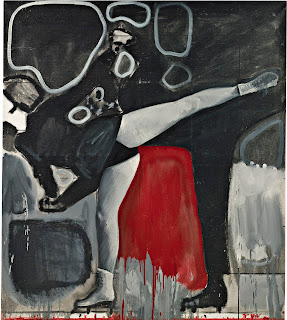F. Dörling, Hamburg, 10th June 1986, lot 7481.
Sotheby's Hong Kong, 19th November 1986, lot 209.
Sotheby's Hong Kong, 'Eight Treasures from a Private Collection', 2nd November 1998, lot 304.
Eskenazi Ltd, London.
Yongle Fruit in Abundance
Regina Krahl
The Yongle reign is the time when the potters at the imperial kilns at Jingdezhen made enormous efforts to refine their materials of body, glaze and pigments, to remodel popular vessel shapes, such as the meiping, by fine-tuning proportions, and to improve decoration by extending their range of motifs,adjusting the layout of their designs, and developing an assured, yet soft painting style. The present vase supplies vivid testimony to the success of these undertakings, its rich repertoire of fruit and flower motifs making it a masterpiece of Yongle porcelain art.
The present vase may originally have formed a pair with a vase in the Palace Museum, Beijing, or a set of four together with two other such vases preserved in Beijing – the only companion pieces recorded – as in the early Ming dynastymeiping were often made in pairs or sets of four. It seems to be the most successfully fired piece of the group, the other three vases all showing excessive 'heaping and piling' on the fruit sprays. This feature as well as the unusually elaborate ornamentation of these vases, where the supporting patterns are rendered with equal attention to variation and detail as the main design, and the different design zones are separated by multiple rather than single or double horizontal lines, all speak for a creation early in the Yongle period, before the design became standardized and thus simplified. Meiping decorated with fruit sprays are well known from the Yongle period, but are otherwise of a much simpler type, showing only six varieties of fruit between formal lappet and leaf borders, and are mostly of smaller size.
The cloud collar at the shoulder, the flamboyant panel band and the broad classic-scroll border around the foot are all ornaments introduced to blue-and-white porcelain in the Yuan dynasty, and particularly the petal border would seem to be based on Middle Eastern stylistic concepts. The 'cusped arches ... terminated with Iranian style three-lobed half-palmettes bending at the top to join up' are briefly discussed in Assadullah Souren Melikian-Chirvani, 'On Some Underglaze Persian Inscriptions in Yuan Period Blue and White Porcelain', Fiftieth Anniversary Exhibition: Twelve Chinese Masterworks, Eskenazi, London, 2010, pp. 27f., where they are linked to Iranian calligraphy of the 13th or 14th century. Because of their similarity to the letters 'l' (lām) and 'a' (alif) in foliated Kufic script, they have become known as lām-alifs.
These wonderfully painted supporting designs are otherwise found only on the best examples of the period. The same cloud collar, lām-alifs and scroll border can be seen, for example, on two covered meiping with a painterly garden scene of plantains, bamboo and rocks, one in the Palace Museum, Beijing, and illustrated in Geng Baochang, ed., Gugong Bowuyuancang Ming chu qinghua ci [Early Ming blue-and-white porcelain in the Palace Museum], Beijing, 2002, vol. 1, pl. 14, the other formerly in the collection of H.R.N. Norton and later the Aso collection, included in the exhibition The Ceramic Art of China, The Victoria and Albert Museum, London, 1971, and sold in our London rooms, 26th March 1963, lot 53.
Of the three companion pieces to this vase, of the same form and design, onemeiping with cover in the Palace Museum, Beijing, has been published in Geng Baochang, op.cit., pl. 15 and p. 34 (fig. 0), where the author also states, p. 40, that the piece embodies the archetypal Yongle style; and a pair of covered vases has been excavated at Xiangshan Dayuan, Haidian district, Beijing (fig. 1 and 2), both today probably in the Capital Museum, Beijing, one illustrated in Zhongguo taoci quanji [Complete series on Chinese ceramics], Shanghai, 1999-2000, vol. 12, pl. 47; the other in Guang Lin, 'Beijing chutu de jixian Mingdai qinghua ciqi [Some Ming blue and white porcelains excavated in Beijing]', Wenwu, 1972, no. 6, pl. 6, fig. 2.
For examples of the more common simpler version, with only six fruit sprays (omitting longan, melon, gingko and grape), see two vases in the Topkapi Saray Museum, Istanbul, included in Regina Krahl, Chinese Ceramics in the Topkapi Saray Museum, Istanbul, ed. John Ayers, London, 1986, vol. 2, no. 624 (fig. 3), where six such vases are held.


















+1988+and+numbered+676-2.Richter.jpg)











































